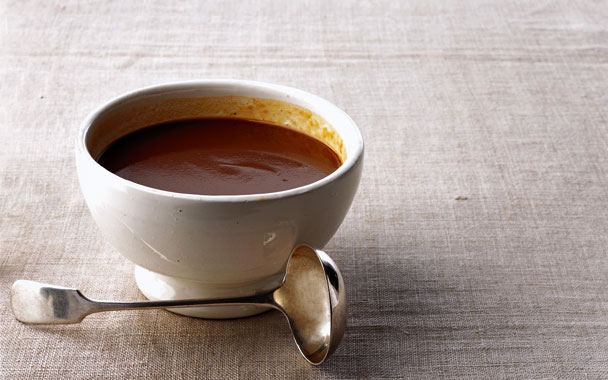The pièce de résistance of Thanksgiving dinner is the turkey, but nothing is more fraught than the gravy, that time-honored indicator of a cook’s prowess. It mustn’t be too thick, too thin, or, God forbid, lumpy. It must be, in a word, velvety. Gravy also requires your attention at the last minute, when all you really want to do is pour yourself a glass of something festive and put your feet up. One way to make life easier is to prepare the stock—the foundation of any self-respecting turkey gravy—ahead of time so you don’t have to babysit a gently simmering stockpot on Thanksgiving morning. For the classic stock, we used the neck and giblets, excluding the liver, that come packed inside the bird. (We gave the quick stock extra oomph by adding the wing tips.) If you buy a fresh turkey, you can make the stock up to three days ahead; even if your turkey is frozen, it should be thawed enough the day before to make extricating that packet of goodness inside the bird feasible. One of the pluses to getting the stock out of the way is that you won’t be tempted to rush through browning the turkey parts. The more thoroughly you brown them and whatever vegetables you’re using, the deeper the finished gravy will be in flavor, as well as in color.
In this issue, we’re giving you four gravies—three are for turkey and trimmings, and one is a robust vegetarian option to ladle over smashed potatoes. What thickens all of them and gives them richness is a little bit of magic that the writer John Egerton calls “a disarmingly simple combination … and at the same time a complex mixture to execute with precision.” What he’s referring to is roux, an amalgam of fat and flour cooked together until the flour no longer tastes raw. Cooking flour in fat (whether butter or reserved fat from the bird’s pan juices) coats the starch granules with the fat, preventing the granules from forming lumps when blended with a liquid.
One way to do this involves whisking together the fat and the flour in a heavy pan (to prevent scorching; if that happens, throw out the roux and start over) and cooking the mixture, whisking constantly, for a few minutes. Although you won’t see the term “deglazing” in our recipes, it just means adding a liquid such as stock and/or white wine (see Roast Turkey with Black-Truffle Butter and White-Wine Gravy and “Why Cook with Alcohol?”) to a hot roasting pan and scraping up the browned (caramelized) bits left from the meat, which are full of flavor. When you make a roux this way (Roast Turkey with Black-Truffle Butter and White-Wine Gravy, Extra-Moist Roast Turkey with Pan Gravy, and Adobo Turkey with Red-Chile Gravy), it becomes much more than a thickener; it lends a nutty essence to the other flavors, extending and amplifying them. In the Roast Turkey with Black Truffle Butter, we’ve handled the mixture in another way: After kneading butter and flour into the classic French paste called beurre manié, we stir it into a boiling stock mixture. The reason we chose this method for the white-wine gravy is that the fat used there is black-truffle butter. You wouldn’t want its unmistakable aroma being stepped on, so to speak, by the nuttiness you get from a roux cooked in the bottom of a pan.
No matter what method you use, if you are making turkey gravy, you’ll need to separate the fat from the pan juices before proceeding, and it doesn’t matter how you go about it. Some of our food editors skim the fat off the top of the juices with a large, shallow spoon or ladle after straining the juices through a sieve. The others prefer to use a fat separator, in which the fat migrates to the top. The juices are then poured out through the long spout located low on the measure. What determines the consistency of the finished gravy is the proportion of those defatted juices (or vegetable stock, in the case of the roasted-garlic gravy) to the fat and flour. For a lightly thickened gravy—one with just the right amount of body—the rule of thumb is one cup liquid to one tablespoon fat and one tablespoon flour. If you keep that ratio in mind, you’ll never again have to worry about making gravy.




 Pinterest
Pinterest






